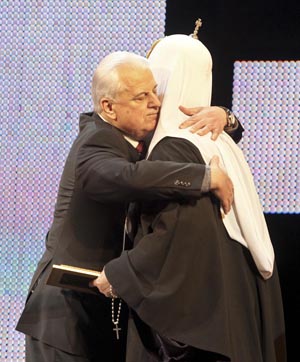The adamantine patriarch
The Primate of the Ukrainian Orthodox Church of the Kyiv Patriarchate celebrates the 50th anniversary of his Episcopal Ordination and 45th anniversary of serving at the Kyiv Cathedral
Last weekend saw the festive events dedicated to the 50th anniversary of the Episcopal Ordination and 45th anniversary of serving at the Kyiv Cathedral of His Beatitude Patriarch of Kyiv and Whole Rus’-Ukraine Filaret.
According to religion expert Andrii YURASH, in the 1,024 years of the Kyiv Cathedral’s operation it has been headed by 98 metropolitans, including Filaret. Talking stats, it means 10.5 years for one primate on average, whereas Filaret has been serving for nearly half a century (so far the term of Metropolitan Kyrylo III’s service in the 13th century, 34 years, has been considered the longest). This time it covers two generations of bishops, both appointed and ordained by Metropolitan Filaret. It covers two generations on the whole, presuming that the productive age makes 20-25 years, when the complete natural reproduction takes place. These are also two epochs, the Soviet and Ukrainian. So no matter what estimates to apply, Patriarch Filaret carves a key figure in our history and the history of the Ukrainian Church.
Now, let’s come to the estimates.
“His Beatitude became the head of the Cathedral in the mid-1960s,” Yurash went on, “That was by far the most difficult period, when great persecutions were taking place. But he succeeded in bringing the process of liquidation of all church structures on the USSR territory to a halt. And when the possibilities for liberalization emerged, he launched several initiatives, which were unprecedented in the after-war period. In particular, he renewed the publication of Pravoslavny visnyk (The Orthodox Herald) as the Lviv-based Episcopal publication at that time and in 1971 relocated it to Kyiv, making it the official newspaper of the Ukrainian exarchate of the Russian Orthodox Church, which has always been published in Ukrainian. He also published the first Ukrainian-language prayer books. In the 1970s he became an influential figure in the life of the Russian Orthodox Church, making the Kyiv Cathedral a leading one and influential in every respect. It is no accident that he aspired to head the Russian Orthodox Church when Patriarch Pimen died. There is one more important thing. His Beatitude Archbishop has an ability to adequately perceive a situation and meet the time. In the late 1980s he faced several challenges: the revival of the Ukrainian Greek Catholic Church and emergence of the autocephalous movement and came to the formula, how one can maximum harmonize the clerical relations in the independent Ukraine, whose appearance was in the offing back then. Back in 1990 he received from Patriarch Alexius II the right for independence in self-governing. Later he began to speak about autocephaly. In my opinion, namely owing to the stand of Patriarch Filaret, who is justly called adamantine by both his followers, and opponents, in the late 1990s and later in the 2000s, the idea of an autocephalous church in Ukraine became a major one under any sociopolitical situation, rather than remaining marginal. Because, unfortunately, the autocephalous movement which emerged in the late 1980s and Ukrainian Autocephalous Orthodox Church showed a traditional Ukrainian disease: lack of management and total lack of coordination in actions.”
“I got acquainted with Patriarch Filaret when he was responsible for celebrating the 1,000th anniversary of the Chriztianization of Rus’-Ukraine,” First President of Ukraine Leonid Kravchuk recalled. “The time was not simple. However, back then I understood that his stand was pro-Ukrainian. Besides, it was clear that His Beatitude was a brilliant theologist, philosopher, and translator [He has translated dozens of church service books and works of Saint Fathers. –Ed.] He has not changed. And now Patriarch as a wise pastor is warning us that a high-tech society without any moral values will eventually find itself in a crisis.”






